符号学基本概念简介
符号学的75个基本概念

符号学的75个基本概念符号学是一门研究符号及其使用的学科,它涵盖了语言学、心理学、社会学等多个领域。
在符号学中,有许多基本概念是我们了解和掌握的关键。
1. 符号:符号是一种用来代表现实世界事物的标记,可以是语言、图像、符号等形式。
2. 符号系统:符号系统是一组符号和规则,用于传达信息和交流思想。
3. 符号化:符号化是将事物或概念转换为符号的过程,使其能够被认知和交流。
4. 符号解释:符号解释是通过理解符号的含义和背后的意义来理解符号的过程。
5. 符号学习:符号学习是通过接触符号和掌握其使用规则来学习符号系统。
6. 符号交流:符号交流是通过符号系统传递和交换信息的过程。
7. 符号生成:符号生成是通过创造新的符号来表达新的概念或思想。
8. 符号语言:符号语言是使用符号来传达意思和进行交流的语言系统。
9. 符号意义:符号意义是符号所代表的概念或事物的含义和价值。
10. 符号理论:符号理论是研究符号的产生、使用和解释的理论。
11. 符号系统分析:符号系统分析是对符号系统进行研究和解释的方法和过程。
12. 符号学派:符号学派是一系列研究符号学的学者和理论家的集合。
13. 符号哲学:符号哲学是研究符号和符号系统的哲学分支。
14. 符号语言学:符号语言学是研究语言符号和语言交流的学科。
15. 符号认知:符号认知是指通过符号系统来理解和认知世界的过程。
16. 符号象征:符号象征是用符号来代表或象征一种概念、情感或价值观。
17. 符号符号化:符号符号化是对符号的再度符号化,使其具有更深层次的含义。
18. 符号解码:符号解码是通过识别和理解符号的含义来解读符号的过程。
19. 符号编码:符号编码是通过选择和安排符号来表达特定的意思。
20. 符号转换:符号转换是将一种符号系统转化为另一种符号系统的过程。
21. 符号传递:符号传递是通过符号系统将信息传送给接收者的过程。
22. 符号演化:符号演化是符号在历史和文化中的变化和发展过程。
符号学的概念
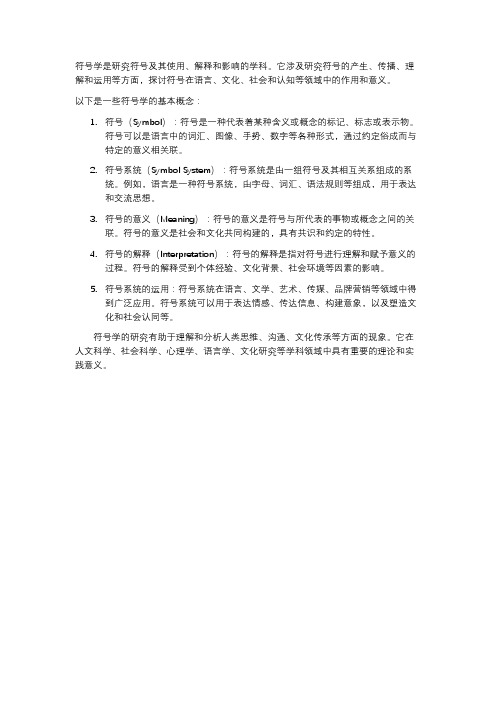
符号学是研究符号及其使用、解释和影响的学科。
它涉及研究符号的产生、传播、理解和运用等方面,探讨符号在语言、文化、社会和认知等领域中的作用和意义。
以下是一些符号学的基本概念:
1.符号(Symbol):符号是一种代表着某种含义或概念的标记、标志或表示物。
符号可以是语言中的词汇、图像、手势、数字等各种形式,通过约定俗成而与特定的意义相关联。
2.符号系统(Symbol System):符号系统是由一组符号及其相互关系组成的系
统。
例如,语言是一种符号系统,由字母、词汇、语法规则等组成,用于表达和交流思想。
3.符号的意义(Meaning):符号的意义是符号与所代表的事物或概念之间的关
联。
符号的意义是社会和文化共同构建的,具有共识和约定的特性。
4.符号的解释(Interpretation):符号的解释是指对符号进行理解和赋予意义的
过程。
符号的解释受到个体经验、文化背景、社会环境等因素的影响。
5.符号系统的运用:符号系统在语言、文学、艺术、传媒、品牌营销等领域中得
到广泛应用。
符号系统可以用于表达情感、传达信息、构建意象,以及塑造文化和社会认同等。
符号学的研究有助于理解和分析人类思维、沟通、文化传承等方面的现象。
它在人文科学、社会科学、心理学、语言学、文化研究等学科领域中具有重要的理论和实践意义。
符号学
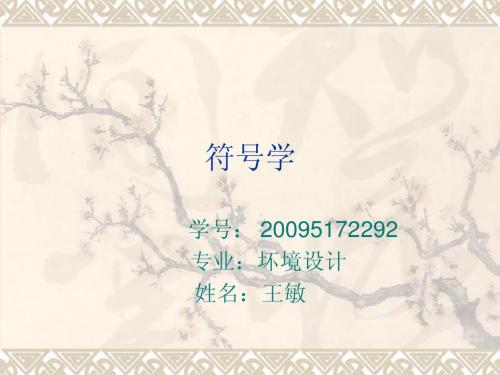
广告案例的符号学分析
一、 isuzu创意广告 1、广告主体原主要符号: (1)掠过水面的汽车 (2)倒影中的“飞马” (3)汽车下方的水面 (4)后面的山 (5)右上角的文字(isuzu) (6)对角上的文字(诞生与成熟)
2、 整体的创意观感(符号关联) 飞越千山万水的车 3、 符号意义: (1)水的禁忌:所有车都该止步的地方 (2)山的禁忌:没有路的山是无法通行的 (3) 我们可以飞越千山万水 (4) 似乎要停在水面上的车:水的表面上十分平 静,却是个危险万分的“温柔的陷阱”,“会飞的 车”似乎可以改变自身的命运 (5 “飞马”:神话传说中经常救人于危难的神圣力 量的化身 (6)给车“插上翅膀” (7)让你的车变成“飞马” (8) “诞生”即“成熟”
符号学
学号: 20095172292 专业:坏境设计 姓名:王敏
符号学的概念
符号学 符号学(Semiotics 或 Semiology)广义上是研究 ) 符号传意的人文科学 当中含盖所有涉文字符、 人文科学, 符号传意的人文科学,当中含盖所有涉文字符、讯 号符、密码、古文明记号、手语的科学。可是, 号符、密码、古文明记号、手语的科学。可是,由 于含盖的范围过于广阔, 于含盖的范围过于广阔,在西方世界的人文科学中 并未得到重视,直至结构主义 结构主义在二十世纪下半期兴 并未得到重视,直至结构主义在二十世纪下半期兴 哲学家, 起,以《Tel Quel》杂志为号召的哲学家,为了反 》杂志为号召的哲学家 对让-保罗 萨特的存在主义 则大量引用俄罗斯 保罗·萨特的存在主义, 俄罗斯在 对让 保罗 萨特的存在主义,则大量引用俄罗斯在 共产革命前的一系列, 共产革命前的一系列,有关符号在文化上的再现过 程的研究,故此,正式出现当今所指的符号学。 程的研究,故此,正式出现当今所指的符号学。
符号学
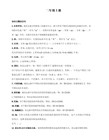
N. S. Trubetzkoy
Russian Formalism
苏联符号学 (1960)
Yury Mikhailovich Lotman
法国结构主义符号学 (1960)
Claude Levi-Strauss
Roland Barthes
总而言之,符号越相象或越接近对象就易于识别,凡是越抽象的或民族文化性的符号识别也就越难。譬如说,欧洲人常在杯子上缠绕蛇来代指医药,东方人难知其意。那些全世界能通用的,最好用相象或越接近对象的共识性符号。如果是文化类型,要根据能指或受指的思维去做。如果二者都无法,就必需使用强制性的规约符号。不过做设计也不需如此严格,用得巧妙是很需要灵感的,了解得越多产生灵感机会就越大,故知识是创造灵感的触点。
现代符号学另一个强大的源头是世纪初瑞士语言学泰斗索绪尔的教学讲稿 ﹣﹣ 《普通语言学教程》,索绪尔将符号分成 意符 Signifier 和 意指 Signified 两个互不从属的部分之后,真正确立了符号学的基本理论,影响了后来李维史陀和罗兰·巴特等法国结构主义的学者,被誉为现代语言学之父。
由于索绪尔把语言符号分成两部份来处理,为研究文化符号或者意识型态的学者,提供了有系统的分析方法学,八十年代至九十年代间,在欧美文化批评界符号学盛极一时。到目前为止,全球学院训练的文化批评者仍有不少使用符号学方法进行文化现象的结构分析。
索绪尔符号学的特点是
单一符号(sign)分成意符(Signifier)和意指(Signified)两部分。意符是符号的语音形象;意指是符号的意义概念部份。由两部份组成的一个整体,称为符号。
【学科原理】
语言学的历史悠久,自古希腊就有语法学,难道中国没有吗?那当然不是,汉代的训诂,西方名噪一时之汉学,在国学中列为小学(文学、训诂学、音韵学),典型的如我们常言的《尔雅》。至于语法学,中国看来要差一些。中西语言学有很大的不同,胡适之曾肤浅地提过,英语重介词之用,中国忽视虚词,常省略。来看看语言学家对符号学的研究,“在索绪尔找到能指和所指这两个词之前,符号这一概念一直含混,因为它总是趋于与单一能指相混淆,而这正是索绪尔所极力避免的。经过对词素与义素、形式与理念、形象与概念等词的一番考虑和犹豫之后,索绪尔选定了能指和所指,二者结合便构成了符号。”③张远山先生的《中西思维层次之差异及其影响》一文中说:“索绪尔所忽视的语言的唯物主义基础:‘受指’,因为真正与能指构成应是受指,实际上正是中国传统学术上熟稔的‘名’与‘实’。能指与受指的结合生产了语言的所指,两个来源构成了所指的两个相关成分,来源与能指的是‘客观所指’即‘义指’(固化为词典释义);来源于‘受指’的是‘主观所指’即‘意指’(体现每一次稍异于词典释义的具体作用),它们的先后关系是‘能指→(义指→意指)→受指’这可以用《周易》八卦中的‘离’卦来表示,初九(阳爻)代表能指,六二(阴爻)代表部分所指,九三(阳爻)代表部分受指。正如中国人把最下的(初九)作为第一爻。那样,中国人的思维方向正好和西方人相反,既‘受指→(意指→义指)→能指’。”“中国人对语言和能指的高度不信任与怀疑”。④据我学国学以来,深知佛道对语言和能指及受指皆不信任。中国人的思维与西方人的差异极大,对符号辨识差异巨大。例如西方用香蕉代表生殖器,中国用藕来代表。西方典型的朱莉叶,中国的祝英台。正如精神分析学专家霍大同先生所言:“男人都是贾宝玉,女人都是林黛玉”。很多人会说,指示标识更是国际化的,譬如,厕所的标识用男人和女人形象来指示,中国人一看便知,西方人一看也知,它的能指和受指并无思维差别。不全如此,西方人演示“八”的时候,张开八根指头。可中国人只需伸出大拇指和食指来表示。这时思维差异就出来了,西方人最终用受指(对象)来体现,中国人用的是能指(名称)来体现,这两个符号固然不同。当我们能指和受指同西方的能指和受指有差异的时候,我们能怎样做指示设计呢?首先,应根据不同的地域思维特色,如少数民族用某种图腾符号来代表自己民族标识。如果我做具有国际性又具有差异性的指示标识设计,往往用民族特色的符号来做。多元文化时代,差异性的符号也是具有国际性的。假如用龙纹做,世界皆知是“中国”,这时龙纹具有指示性和民族性。没有差异的国际性指示标识,往往采用共识性符号,如螺栓的型号全球通用,若是做指示设计就容易多了。
符号学的75个基本概念

符号学的75个基本概念符号学是研究符号及其使用的学科领域,涉及到语言、文字、符号系统等方面。
下面列举了符号学的75个基本概念,帮助我们了解符号学的基本理论和应用。
1. 符号:指代某种事物、概念或想法的视觉、听觉、触觉或语言表达。
2. 符号系统:一组符号及其相互关系的集合,用于传递特定信息。
3. 符号学:研究符号及其使用的学科领域,涵盖语言学、心理学、社会学等多个学科。
4. 符号的产生与发展:符号的起源及其在文化和社会发展中的演化过程。
5. 符号的意义与解释:符号的意义是由社会、历史和文化背景所决定的,并可以通过不同的解释而产生不同的理解。
6. 符号的生成:人类使用符号来表达自己的思想、情感和经验。
7. 符号学家:研究符号学的学者,使用符号学理论分析和解释不同符号系统。
8. 符号与语言:符号是语言的基本单元,通过语法和语义规则组织和传递信息。
9. 语言符号系统:语言的符号系统由词汇、语法、语义和语用等组成,用于交流和表达思想。
10. 文字符号系统:文字是一种特定的符号系统,用于记录和传递信息,具有持久和广泛传播的特点。
11. 图像符号系统:图像是一种视觉符号系统,通过视觉元素表达和传递特定信息。
12. 数学符号系统:数学是一种用符号表示和推理的系统,用于描述和解决数量和结构方面的问题。
13. 简化符号系统:为了简化和加快信息传递,人们常常使用简化的符号系统,如缩略语、符号和图表等。
14. 比喻与象征:比喻和象征是通过符号来传达隐含意义的一种表达方式。
15. 符号的多义性:符号可以有不同的意义和解释,取决于上下文和使用者的理解。
16. 符号的一般性:某些符号和符号系统具有普遍性,跨越不同的文化和社会背景。
17. 符号的特殊性:某些符号和符号系统只在特定的文化、社会和群体中有特殊意义和用途。
18. 符号的共时性:符号以及符号系统的意义是在特定的时空背景中构建和理解的。
19. 符号的历史性:符号在历史进程中产生、发展和变异,反映了特定时期和文化的特征。
符号学与意义的世界

符号学与意义的世界符号学是一门研究符号及其意义的学科,它探讨了符号在人类思维和交流中的作用。
符号学的研究范围涉及语言、文字、图像、音乐等各种形式的符号系统。
通过对符号的解读和分析,我们可以更好地理解人类文化、思维和社会交往。
本文将介绍符号学的基本概念和意义,并探讨符号学在现代社会中的应用。
一、符号学的基本概念符号学的起源可以追溯到古代哲学家和语言学家的思考。
但是,符号学作为一门独立的学科,直到20世纪才得到了广泛的发展。
符号学的基本概念包括符号、意义和解释。
1. 符号:符号是一种代表事物或概念的标记或表示。
符号可以是语言中的词汇、文字中的字母、图像中的图形等。
符号通过与特定的事物或概念相关联,传达信息和意义。
2. 意义:意义是符号所代表的事物或概念的内涵。
意义是通过符号与特定事物或概念的关联而产生的。
不同的符号可以传达不同的意义,而同一个符号在不同的语境中可能具有不同的意义。
3. 解释:解释是对符号所传达的意义进行理解和解读的过程。
解释符号需要考虑符号本身的特点、符号与事物或概念的关系以及符号在特定语境中的意义。
二、符号学的意义符号学的研究对于我们理解和解释世界具有重要意义。
以下是符号学的几个重要意义:1. 文化理解:符号是文化的重要组成部分。
通过研究符号,我们可以更好地理解不同文化之间的差异和相似之处。
符号学帮助我们理解文化的象征、价值观和社会规范。
2. 语言研究:符号学对语言学的发展有着重要影响。
符号学的研究使我们能够更好地理解语言的结构、语义和语用。
符号学的方法也被应用于翻译、语言教学和语言技术等领域。
3. 意义建构:符号学研究了意义的建构过程。
通过研究符号的使用和解释,我们可以了解人们如何通过符号来构建和传递意义。
这对于理解人类思维、行为和社会交往具有重要意义。
4. 传媒与广告:符号学在传媒和广告领域有着广泛的应用。
通过研究符号的使用和解读,我们可以更好地理解广告和媒体对受众的影响。
符号学的研究可以帮助我们分析和评估广告和媒体的效果。
符号学
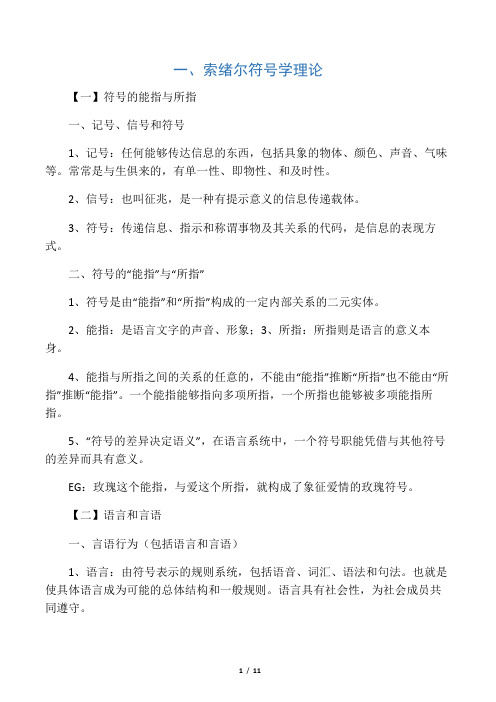
一、索绪尔符号学理论【一】符号的能指与所指一、记号、信号和符号1、记号:任何能够传达信息的东西,包括具象的物体、颜色、声音、气味等。
常常是与生俱来的,有单一性、即物性、和及时性。
2、信号:也叫征兆,是一种有提示意义的信息传递载体。
3、符号:传递信息、指示和称谓事物及其关系的代码,是信息的表现方式。
二、符号的“能指”与“所指”1、符号是由“能指”和“所指”构成的一定内部关系的二元实体。
2、能指:是语言文字的声音、形象;3、所指:所指则是语言的意义本身。
4、能指与所指之间的关系的任意的,不能由“能指”推断“所指”也不能由“所指”推断“能指”。
一个能指能够指向多项所指,一个所指也能够被多项能指所指。
5、“符号的差异决定语义”,在语言系统中,一个符号职能凭借与其他符号的差异而具有意义。
EG:玫瑰这个能指,与爱这个所指,就构成了象征爱情的玫瑰符号。
【二】语言和言语一、言语行为(包括语言和言语)1、语言:由符号表示的规则系统,包括语音、词汇、语法和句法。
也就是使具体语言成为可能的总体结构和一般规则。
语言具有社会性,为社会成员共同遵守。
2、言语:进入实际使用阶段的个人言语行为,是语言的具体表现和运用。
言语是个人的、异质的。
二、语言和言语的关系:1、语言和言语是相互区别也是相互依存的。
2、语言是言语的工具又是他的产物;没有语言,言语就失去了同一的系统;没有言语,语言也不会建立起来。
【三】语言的“共时态”和“历时态”——也就是符号的“可变性”和“不可变性”一、时间因素使语言符号具有不变的一面,也有可变的一面。
二、共时态:是指暂时把符号看做静止的状态,研究某一特定集体所共享的符号,研究他们的结构、组成等。
三、历时态:符号是变化发展的,从历史发展上来研究符号的变化的特征。
【四】“组合(句段)关系”和“联想(聚合)关系”一、语言符号系统是一个由“组合(句段)关系”和“联想(聚合)关系构成的关系网络。
二、“组合(句段)关系”:符号按照线性排列所组成的要素与要素之间的关系,体现符号的线性特征。
符号学的概念

符号学的概念什么是符号学符号学是一门研究符号系统的学科,它关注符号的构成、使用和意义。
符号学可以应用于语言学、心理学、社会学等多个领域,帮助人们理解符号系统在人类文化和认知中的重要作用。
符号的定义符号是一种代表或表达某种概念、概念群体或其他东西的记录或表征。
符号可以是文字、图像、声音或其他感官形式。
符号的使用基于共同的约定,即符号与所代表的对象之间存在一种公认的联系。
符号的三个要素符号包含三个要素:符号形式、符号内容和符号使用。
符号形式是符号的外在表现形式,比如文字的字母、图像的形状等。
符号内容是符号所代表的具体概念、对象或意义。
符号使用涉及到符号的生成、传播和解释。
符号的分类符号可以按照不同的维度进行分类。
常见的分类方式包括:1. 语言符号 vs. 非语言符号语言符号是通过语言系统进行表达的符号,包括文字、口语和手语等。
非语言符号则是通过图像、手势、音乐等非语言形式进行表达的符号。
2. 指示性符号 vs. 表示性符号指示性符号直接指向所代表的对象或概念,比如路牌指示前方的道路或地点。
表示性符号则是通过某种规定的约定与所代表的对象或概念相关联,比如红色在某些文化中代表危险或警示。
3. 存在性符号 vs. 表示性符号存在性符号是直接存在于所代表的对象上的符号,比如动物的外貌和行为特征。
表示性符号则是用来表达对象的符号,比如动物形象的图像或文字描述。
4. 表征符号 vs. 规约符号表征符号直接表示所代表的对象或概念的特征和属性,比如天平和正负号。
规约符号是一种约定俗成的符号系统,比如音符和文字字母,它们本身没有直接的表征意义,而是在符号系统中与其他符号形成关联从而表达意义。
符号学在社会科学中的应用符号学在社会科学中有着广泛的应用。
以下是一些符号学在不同领域中的具体应用示例:1. 文化研究符号学可以帮助研究者理解不同文化中的符号系统和其背后的意义。
通过研究符号在文化中的传播和解释方式,可以揭示出文化差异和共通性,帮助人们更好地理解不同文化之间的交流和互动。
符号学基本概念简介课件

04
符号学在各领域的应用
广告与市场营销
广告语言
符号学可以帮助理解广告语言中 的符号意义,以及如何通过符号 传达特定的信息或情感,从而更 好地设计和传播广告。
品牌形象
符号学可以研究品牌形象中的符 号意义,了解消费者对品牌的认 知和情感反应,从而更好地塑造 和管理品牌形象。
市场策略
符号学可以分析市场中的符号和 符号系统,了解消费者对产品的 认知和需求,从而制定更有效的 市场策略。
05
符号学的挑战与未来发展
符号学的跨学科研究
01
02
03
符号学与语言学
语言是符号的主要载体, 语言学为符号学提供了丰 富的理论和实践基础。
符号学与心理学
心理学关注符号在人类心 理活动中的作用,探究符 号如何影响人的认知和行 为。
符号学与文化研究
文化研究关注符号在文化 交流、传播和建构中的作 用,探究符号与文化的关 系。
。
艺术符号学
研究艺术作品中的符 号和意义,涉及美学 、艺术批评和文化研
究等方面。
02
符号的分类与特性
语言符号
总结词
语言符号是人类通过约定俗成的规则,用特定的声音或 书写形式来表达特定意义的方式。
详细描述
语言符号包括口头语言和书面语言,它们是由音素、词 素、词、短语等组成。语言符号具有约定性和社会性, 它们是人们交流思想和信息的主要工具。
象征符号
总结词
象征符号是通过象征或代表某种概念、事物或品质来表达意 义的符号。
详细描述
象征符号包括国旗、徽章、宗教符号等,它们通过特定的形 象或标志来传达特定的意义或价值观念。象征符号具有抽象 性和文化性,在不同的文化和社会中有不同的象征意义。
符号学:解读非言语的文字符号

• 分析非言语文字符号的生成 机制和传播过程 • 揭示非言语文字符号的意义 和功能
符号学在心理学中的应用
符号学在非言语文字符号解读中的应用
• 分析非言语文字符号在认知和情感表达中的作用 • 揭示非言语文字符号对心理活动的影响
符号学在心理学中的应用
• 研究认知过程和情感表达中的符号现象 • 揭示符号在心理活动中的作用
02
非言语文字符号的接收
• 接收者需要具备一定的认知能力和文化 背景 • 接收过程可能受到个人经验、情感等因 素的影响
03
符号学在解读非言语文字符号中的应用
符号学在语言学中的应用
符号学在语言 学中的应用
01
• 研究言语符号的生成、传播 和解释过程 • 揭示言语符号的意义和功能
符号学在非言 语文字符号解 读中的应用
非言语文字符号的解读实例分析
• 非言语文字符号的解读实例分析 • 分析绘画、雕塑等图像符号的意义和功能 • 分析肢体语言、表情等手势符号的意义和功能 • 分析音乐、声音等声音符号的意义和功能
非言语文字符号解读的局限性及其应对策略
非言语文字符号解读的局限性
• 可能受到个人经验、情感等因素的影 响 • 可能受到语境、文化等因素的限制
02
符号学的基本方法
• 符号学分析:通过对符号的生成、 传播和解释过程进行分析,揭示符号 的意义 • 符号学比较:比较不同文化、历 史和社会背景下的符号差异
02
非言语文字符号的类型与特点
非言语文字符号的定义与分类
非言语文字符号的定义
• 非言语文字符号是一种不依赖于语言 的符号系统,通过图像、手势、表情等 方式传递信息 • 与言语符号相对立,但相互补充
非言语文字符号解读的应对策略
符号学基本概念与在新媒体的运用
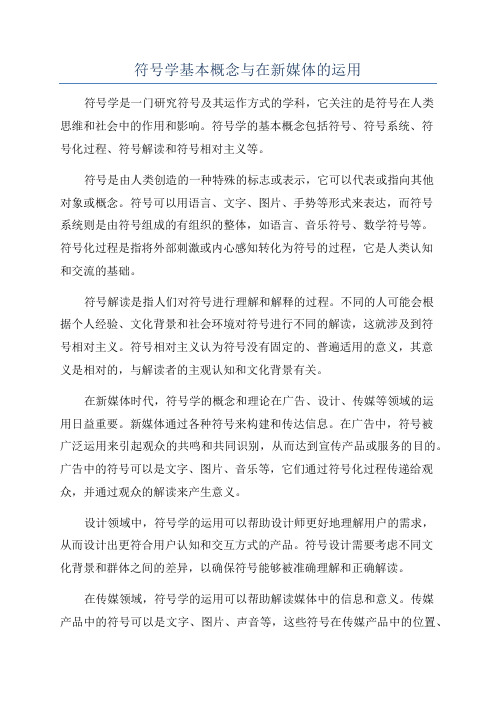
符号学基本概念与在新媒体的运用符号学是一门研究符号及其运作方式的学科,它关注的是符号在人类思维和社会中的作用和影响。
符号学的基本概念包括符号、符号系统、符号化过程、符号解读和符号相对主义等。
符号是由人类创造的一种特殊的标志或表示,它可以代表或指向其他对象或概念。
符号可以用语言、文字、图片、手势等形式来表达,而符号系统则是由符号组成的有组织的整体,如语言、音乐符号、数学符号等。
符号化过程是指将外部刺激或内心感知转化为符号的过程,它是人类认知和交流的基础。
符号解读是指人们对符号进行理解和解释的过程。
不同的人可能会根据个人经验、文化背景和社会环境对符号进行不同的解读,这就涉及到符号相对主义。
符号相对主义认为符号没有固定的、普遍适用的意义,其意义是相对的,与解读者的主观认知和文化背景有关。
在新媒体时代,符号学的概念和理论在广告、设计、传媒等领域的运用日益重要。
新媒体通过各种符号来构建和传达信息。
在广告中,符号被广泛运用来引起观众的共鸣和共同识别,从而达到宣传产品或服务的目的。
广告中的符号可以是文字、图片、音乐等,它们通过符号化过程传递给观众,并通过观众的解读来产生意义。
设计领域中,符号学的运用可以帮助设计师更好地理解用户的需求,从而设计出更符合用户认知和交互方式的产品。
符号设计需要考虑不同文化背景和群体之间的差异,以确保符号能够被准确理解和正确解读。
在传媒领域,符号学的运用可以帮助解读媒体中的信息和意义。
传媒产品中的符号可以是文字、图片、声音等,这些符号在传媒产品中的位置、形式和背景都可以影响观众的解读。
符号学可以帮助我们理解媒体如何通过符号构建和传达特定的意义和价值观。
总之,符号学是一门研究符号及其运作方式的学科,它涉及到符号、符号系统、符号化过程、符号解读和符号相对主义等基本概念。
在新媒体时代,符号学的概念和理论在广告、设计、传媒等领域的运用日益重要,它可以帮助我们更好地理解和运用符号,从而构建和传达信息。
符号学
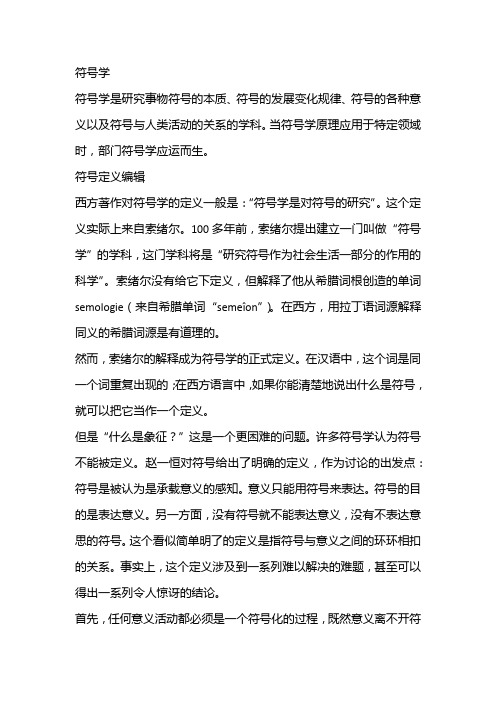
符号学符号学是研究事物符号的本质、符号的发展变化规律、符号的各种意义以及符号与人类活动的关系的学科。
当符号学原理应用于特定领域时,部门符号学应运而生。
符号定义编辑西方著作对符号学的定义一般是:“符号学是对符号的研究”。
这个定义实际上来自索绪尔。
100多年前,索绪尔提出建立一门叫做“符号学”的学科,这门学科将是“研究符号作为社会生活一部分的作用的科学”。
索绪尔没有给它下定义,但解释了他从希腊词根创造的单词semologie(来自希腊单词“semeîon”)。
在西方,用拉丁语词源解释同义的希腊词源是有道理的。
然而,索绪尔的解释成为符号学的正式定义。
在汉语中,这个词是同一个词重复出现的;在西方语言中,如果你能清楚地说出什么是符号,就可以把它当作一个定义。
但是“什么是象征?”这是一个更困难的问题。
许多符号学认为符号不能被定义。
赵一恒对符号给出了明确的定义,作为讨论的出发点:符号是被认为是承载意义的感知。
意义只能用符号来表达。
符号的目的是表达意义。
另一方面,没有符号就不能表达意义,没有不表达意思的符号。
这个看似简单明了的定义是指符号与意义之间的环环相扣的关系。
事实上,这个定义涉及到一系列难以解决的难题,甚至可以得出一系列令人惊讶的结论。
首先,任何意义活动都必须是一个符号化的过程,既然意义离不开符号,那么意义就必须是符号的意义。
符号不仅是意义的工具或载体,也是意义的条件:只有符号才能进行意义活动,没有符号,意义就不可能存在。
因此,为了定义符号,我们必须定义意义。
要说任何意义,就必须用另一种意义;判断一件事是否有意义,也就是说,它是可以解释和可以解释的。
所有能解释意义的东西都是符号。
因此,意义有一个同样清晰而简单的定义:意义是一个符号被其他符号解释的潜力,而解释是意义的实现。
意义只能用符号来解释,符号是用来解释意义的。
相反地,没有符号可以解释的意思,也没有不解释意义的符号。
这句话听起来很纠结,但实际上它有一个简单的含义:意义包括两个基本环节:发送(表达)和接收(解释)。
符号学的75个基本概念
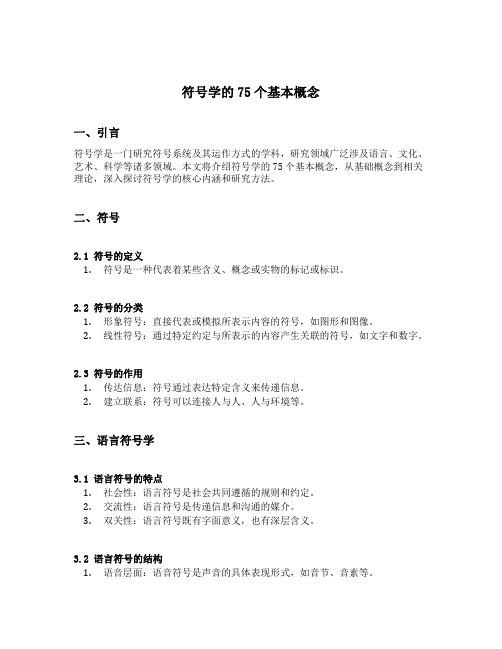
符号学的75个基本概念一、引言符号学是一门研究符号系统及其运作方式的学科,研究领域广泛涉及语言、文化、艺术、科学等诸多领域。
本文将介绍符号学的75个基本概念,从基础概念到相关理论,深入探讨符号学的核心内涵和研究方法。
二、符号2.1 符号的定义1.符号是一种代表着某些含义、概念或实物的标记或标识。
2.2 符号的分类1.形象符号:直接代表或模拟所表示内容的符号,如图形和图像。
2.线性符号:通过特定约定与所表示的内容产生关联的符号,如文字和数字。
2.3 符号的作用1.传达信息:符号通过表达特定含义来传递信息。
2.建立联系:符号可以连接人与人、人与环境等。
三、语言符号学3.1 语言符号的特点1.社会性:语言符号是社会共同遵循的规则和约定。
2.交流性:语言符号是传递信息和沟通的媒介。
3.双关性:语言符号既有字面意义,也有深层含义。
3.2 语言符号的结构1.语音层面:语音符号是声音的具体表现形式,如音节、音素等。
2.语法层面:语法规则决定了符号如何组合和运用。
3.语义层面:通过符号所代表的意义来传达信息。
3.3 语用学1.语用学研究语言符号的使用情境、含义和效果。
2.语言行为和交际意图是语用学的核心概念。
四、符号学理论4.1 符号交换理论1.符号交换理论探讨符号在人类交流中的作用和影响。
2.符号交换可以通过语言、动作、表情等方式进行。
4.2 符号学结构主义1.符号学结构主义关注符号系统的内在结构和关联。
2.符号间的对比、对立和关系是研究的核心。
4.3 符号场理论1.符号场理论认为符号是在特定背景下被理解和使用的。
2.背景因素可以包括文化、社会和历史等。
4.4 符号学的实用应用1.广告与市场营销:符号在广告中的运用可以影响消费者的购买行为和品牌认知。
2.社会学研究:符号学可以帮助理解社会文化现象中的符号象征意义。
五、结论符号学作为一门关注符号系统的学科,涉及广泛且深入的研究内容。
本文从基本概念到相关理论,介绍了符号学的核心内容,包括符号的定义、分类和作用,语言符号学的特点和结构,以及符号交换理论、符号学结构主义和符号场理论等符号学理论。
设计符号学15个问题

设计符号学(十五道关于设计符号学的问题)学号:3312050001143班级:12级设计学(服装设计方向)姓名:杨萌玮1.符号学的基本概念、特征,主要流派的代表人物及学术观点符号学,顾名思义,是研究符号的理论和方法。
表明符号是由什么构成、符号受什么规律支配。
因此,称之为符号学的符号科学研究那些作为一切符号结构的基础的一般原则,研究它们在信息中的运用,研究各种各样符号系统的特殊性,以及使用那些不同种类符号的特殊性。
产生于本世纪50到60年代,由法国和意大利为中心兴盛至整个欧洲各国。
符号学的特征:1. 普遍性:符号对我们来说,是普遍存在的。
甚至是时时存在,事事存在的。
2. 稳定性:符号的稳定性,是指符号一旦形成,就会以相对固定的形式—文字形式、语言形式、图片形式、动作形式等记录和流传下来,成为一种知识,成为未来人们在解决类似问题的参考答案。
3. 可认知性:在如今这个大信息量的社会中,人们对符号的期待更加的渴望—他们希望得到更加直接和有效地符号。
4. 继承性:这一特性使我们在研究和使用人们熟知的符号时,也就具备了更强的可靠性,也因此使符号具备了可操作性和研究参考性。
符号学学派列表:1. 美国皮尔斯理论系统:一般符号学研究方向。
代表人物:查尔斯·桑德斯·皮尔斯,美国实用主义哲学家、现代符号学奠基人之一。
注重符号的逻辑功能,创建了广义符号学。
广义符号学,把符号理解为代表或表现其他事物的东西,可以被人所理解或解释,并对人具有一定的意义。
皮尔斯认为,符号由三种要素所构成:其一为所指事物,它是一种物质存在,用于表征或者替代某一对象;其二为能指,即符号所指称或表征的事物,其三为意义、相关概念,即为人所理解并传达出一定意义。
2. 瑞士索绪尔理论系统:带有语言学倾向的符号学研究方向。
代表人物:索绪尔。
索绪尔认为语言符号最重要的性质是其任意性。
任意性是指所指与能指之间的联系是任意的,约定俗成的。
叶姆斯列夫、巴特。
符号学
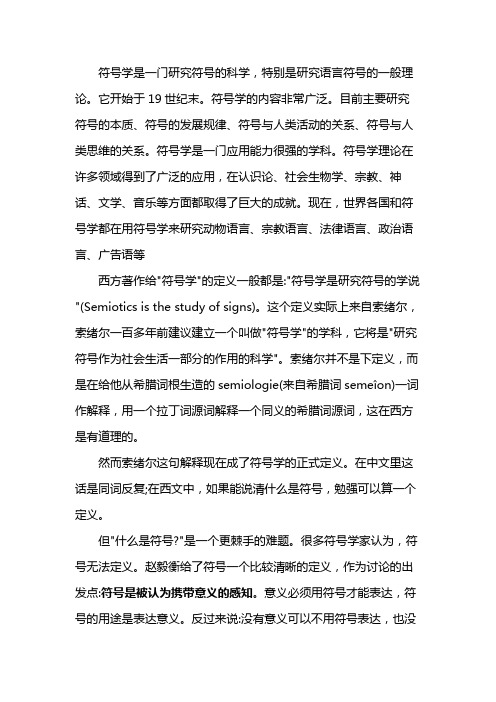
符号学是一门研究符号的科学,特别是研究语言符号的一般理论。
它开始于19世纪末。
符号学的内容非常广泛。
目前主要研究符号的本质、符号的发展规律、符号与人类活动的关系、符号与人类思维的关系。
符号学是一门应用能力很强的学科。
符号学理论在许多领域得到了广泛的应用,在认识论、社会生物学、宗教、神话、文学、音乐等方面都取得了巨大的成就。
现在,世界各国和符号学都在用符号学来研究动物语言、宗教语言、法律语言、政治语言、广告语等西方著作给"符号学"的定义一般都是:"符号学是研究符号的学说"(Semiotics is the study of signs)。
这个定义实际上来自索绪尔,索绪尔一百多年前建议建立一个叫做"符号学"的学科,它将是"研究符号作为社会生活一部分的作用的科学"。
索绪尔并不是下定义,而是在给他从希腊词根生造的semiologie(来自希腊词semeîon)一词作解释,用一个拉丁词源词解释一个同义的希腊词源词,这在西方是有道理的。
然而索绪尔这句解释现在成了符号学的正式定义。
在中文里这话是同词反复;在西文中,如果能说清什么是符号,勉强可以算一个定义。
但"什么是符号?"是一个更棘手的难题。
很多符号学家认为,符号无法定义。
赵毅衡给了符号一个比较清晰的定义,作为讨论的出发点:符号是被认为携带意义的感知。
意义必须用符号才能表达,符号的用途是表达意义。
反过来说:没有意义可以不用符号表达,也没有不表达意义的符号。
这个定义,看起来简单而清楚,翻来覆去说的是符号与意义的锁合关系。
实际上这定义卷入一连串至今难以明确解答的难题,甚至可以得出一系列令人吃惊的结论。
符号学

符号学符号学是研究事物符号的本质、符号的各种意义、符号的发展变化规律、以及符号与人类多种活动之间的关系。
符号学的原理被应用到各具体领域,因此而产生了部门符号学。
西方著作给“符号学”的定义一般都是:“符号学是研究符号的学说”(Semiotics is the study of signs)。
这个定义实际上来自索绪尔,索绪尔一百多年前建议建立一个叫做“符号学”的学科,是一个将“研究符号作为社会生活一部分的作用的科学”。
索绪尔并不是下定义,而是在给他的semiologie(来自希腊词semeîon)一词作解释,这个词来自于希腊词根,他尝试用一个拉丁词源词解释一个同义的希腊词源词。
这在西方是有道理的。
符号:很多符号学家认为,符号无法定义。
赵毅衡给了符号一个比较清晰的定义,作为讨论的出发点:符号是被认为携带意义的感知。
意义必须用符号才能表达,符号的用途是表达意义。
符号学:赵毅衡在1993年把符号学定义为:“关于意义活动的学说。
”并给出了符号的定义。
即“符号是被认为携带意义的感知:意义必须用符号才能表达,符号的用途是表达意义。
反过来说,没有意义可以不用符号表达,也没有不表达意义的符号。
”没有意义的表达和理解,不仅人无法存在,“人化”的世界无法存在,人的思想也不可能存在,因为我们只有用符号才能思想,或者说,思想也是一个产生并且接收符号的过程。
因此,认识论、语意学、逻辑学、现象学、解释学、心理学,都只涉及意义活动的一个方面,而符号学是对意义的全面讨论。
因此把符号学定义为“意义学”是能够成立的,也是有用的。
这样讨论的目的,是确定符号学涉及的范围。
很多人认为符号学就是研究人类文化的。
实际上,文化的确是最大的一个领域,但是符号学还研究认知活动,心灵活动,一切有关意义的活动,甚至包括一切由有灵之物的认知与心灵活动。
符号是人存在的本质条件。
这是因为,人类为了肯定自身的存在,必须寻找存在的意义。
- 1、下载文档前请自行甄别文档内容的完整性,平台不提供额外的编辑、内容补充、找答案等附加服务。
- 2、"仅部分预览"的文档,不可在线预览部分如存在完整性等问题,可反馈申请退款(可完整预览的文档不适用该条件!)。
- 3、如文档侵犯您的权益,请联系客服反馈,我们会尽快为您处理(人工客服工作时间:9:00-18:30)。
(Stands for) Figure 4.3 Semantic triangle (see 王铭玉2001:42; Eco 1990:67)
皮尔士三分法 A trichotomy of signs: icon, index, and symbol
Peirce divides signs by three trichotomies (later he discovered ten trichotomies and sixtysix classes of signs). Firstly, in terms of the characteristics of the sign itself, a sign may be a mere quality, an actual existence, or a general law; Secondly, in terms of relation, signs are divided according as the relation of the sign to its object consists in the sign’s having some character in itself, or in some existential relation to that object, or in its relation to an interpretant; Thirdly, according as its Interpretant represents it as a sign of possible or as a sign of fact or a sign of reason.
能指与所指signifier & signified: 能指与所指 :
Saussure moves further to explain: “ In our terminology a sign is the combination of a concept and a sound pattern. But in current usage the term sign generally refers to the sound pattern alone, e.g. the word form arbor …the ambiguity would be removed if the three notions in question were designated by terms which are related but contrast. We propose to keep the term sign to designate the whole, but to replace concept and sound pattern respectively by signification and signal. The latter terms have the advantage of indicating the distinction which separates each from the other and both from the whole of which they are part.”(1972, 2001:67)
Signification is the sense of the sign which is the thing or idea the sign refers to, while signal is the form, in most cases the written words. The two are respectively called ‘signified’ and ‘signifier’ later by Saussure’s followers, for example Roland Barthes (1999). Signifier may be regarded as the linguistic form of language, and signified the content. The distinction between signifier and signified reveals the two dimensions of language, namely the dimension of expression and the dimension of content.
2) INDEX “An Index is a sign which refers to the Object that it denotes by virtue of being really affected by that Object. ……It does, therefore, involve a sort of Icon ……” (CP vol. 2: 143). If the sign be an Index, it can be considered as a fragment torn away from the object, the relation between the sign and the object is the relation between the whole and a part. An index reminds us of the existence of its object. For example, the contents of a book may be considered as the index of the book itself. Another example is footprint. Footprint on the sands may remind of presence of a man who has walked away from here.
什么是符号学? 什么是符号学?
符号学的思想是在20世纪初由瑞士语言学家索绪 尔(Saussure)首先提出的,在其《普通语言 学教程》一书中写道:“我们可以设想有一门研 研 究社会中符号生命的科学… 究社会中符号生命的科学 …我将把它叫做符 号学。符号学将表明符号是由什么构成,符号受 什么规律支配。因为这门科学还不存在,谁也说 不出它将会是什么样子,但是它有存在的权利, 它的地位预先已经确定了。”(索绪尔,1985: 38)
三项式关系( 三项式关系(triadic relation): ): A Representamen is the First Correlate of a triadic relation, the Second Correlate being termed its Object, and the possible Third Correlate being termed its Interpretant. In Peirce’s view, triadic relation, which is formed by three correlates, namely the sign as the first correlate, the object as the second correlate and the interpretant as the third correlate, is the essential characteristic of sign.
3) SYMBOL “A Symbol is a sign which refers to the Object that it denotes by virtue of a law, usually an association of general ideas, which operates to cause the symbol to be interpreted as referring to that Object. It is thus itself a general type or law, that it, is a Legisign. ……and thus the Symbol will involve a sort of Index, …” (CP vol. 2:144) For instance, pigeon is the symbol of peace, scales are the symbol of justice. Symbols stand for their objects by social and cultural conventions, for example, the Great Wall symbolizes China, dragon also symbolizes China because they are conventionally considered so.
This triadic relation can be expressed in diagram as below: Interpretant
Sign
Object
Figure 4.2 Triadic relation (see Eco, 1990:67)
The diagram is transformed to illustrate the Theory of Semantic Triangle co-established by Ogden, C. and Richards, I. A. The basic principle of this theory can be exhibited by a triangle: Concept (Thought) (Symbolizes) Symbol(word) (Refers to) Referent (thing)
符号学基本概念简介
什么是符号? 什么是符号? What is a sign? As Peirce sees it, A sign, or representamen, is something which stands to somebody for something in some respect or capacity. (CP vol.2: 135) A sign can be verbal or non-verbal.
